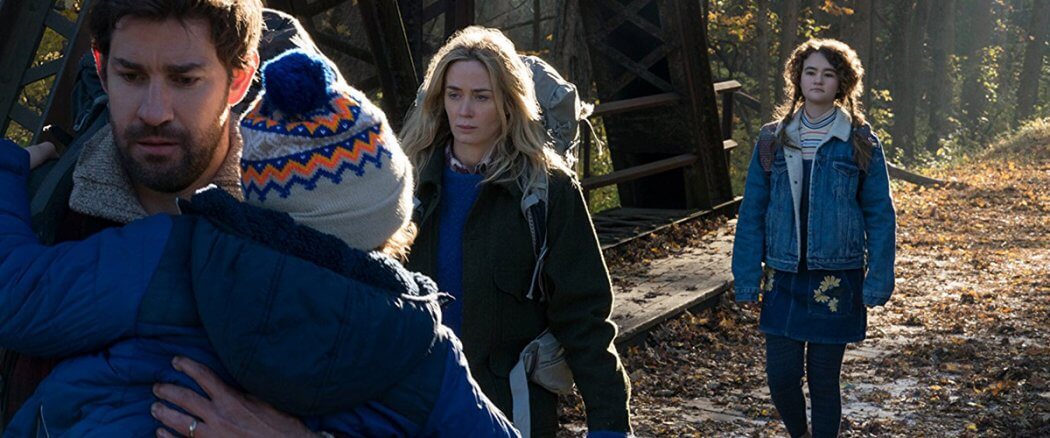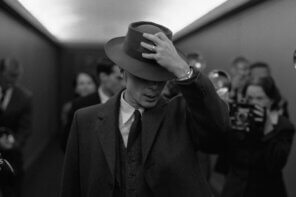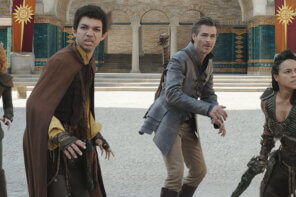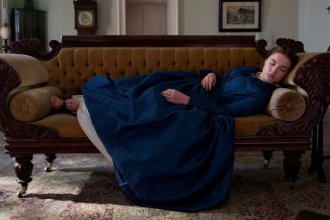A young family faces the horrors of an unearthly enemy where even the smallest sound means a gruesome death. Actor/director John Krasinski (yes, it’s a bearded Jim from The Office) stars with Emily Blunt (Mary Poppins forthcoming) in a tight, intense thriller that’s equal parts monster movie and interpersonal drama. You don’t have to strain too hard to see A Quiet Place as a parable about the fears of parenthood and raising children in a dangerous world. Krasinki’s direction shows an eye for composition (it doesn’t hurt that the film was shot during autumn in the Hudson Valley) and a skill for wringing emotion and narrative out of a movie that’s 90% without exposition (it doesn’t hurt that Emily Blunt is an actress in full control of her craft). For some the horror elements might be too intense, but if a little evisceration doesn’t bother you A Quiet Place is well worth your time and stands up against films like The Sixth Sense that have found a striking balance between pathos and supernatural dread.
Meet the Abbotts
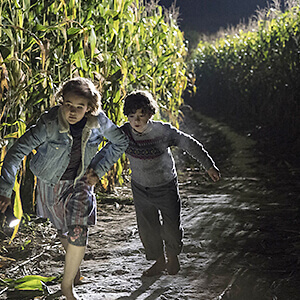 At $17 million, A Quiet Place is not exactly low-budget, but at five times the cost the recent Tomb Raider reboot will be hard-pressed to cash in on its legacy name recognition to make its budget back. Krasinki’s small film tripled its budget in one weekend; that’s the power of a well-executed concept and great acting over hype and CGI set pieces. There are seven actors in A Quiet Place: one is a newborn and one is an old man who mirror each other’s dialogue (a single scream) at either end of life. Of the remaining five, three are children playing siblings with all the pettiness and tenderness of real-life siblings. Deaf actress Millicent Simmonds (Wonderstruck – streaming on Amazon Prime) is the eldest daughter, Regan. In a world where every sound could mean death, adding a deaf character is either cruelly ironic or brilliant. Much of the script is signed (ASL), and the physical expressiveness of each actor is put to the test by the level playing field of silence. Watching the family move through their silent routines is some of the most interesting storytelling: a string of white lights that turn red at the flip of a switch to sound the alarm; a trip to a nearby waterfall; sound-proofing a root cellar; walking to an abandoned town on paths made of carefully maintained, sound-deadening sand. Every act ratchets up the tension when the slightest wrong movement could make a noise that will trigger unstoppable, alien hunters.
At $17 million, A Quiet Place is not exactly low-budget, but at five times the cost the recent Tomb Raider reboot will be hard-pressed to cash in on its legacy name recognition to make its budget back. Krasinki’s small film tripled its budget in one weekend; that’s the power of a well-executed concept and great acting over hype and CGI set pieces. There are seven actors in A Quiet Place: one is a newborn and one is an old man who mirror each other’s dialogue (a single scream) at either end of life. Of the remaining five, three are children playing siblings with all the pettiness and tenderness of real-life siblings. Deaf actress Millicent Simmonds (Wonderstruck – streaming on Amazon Prime) is the eldest daughter, Regan. In a world where every sound could mean death, adding a deaf character is either cruelly ironic or brilliant. Much of the script is signed (ASL), and the physical expressiveness of each actor is put to the test by the level playing field of silence. Watching the family move through their silent routines is some of the most interesting storytelling: a string of white lights that turn red at the flip of a switch to sound the alarm; a trip to a nearby waterfall; sound-proofing a root cellar; walking to an abandoned town on paths made of carefully maintained, sound-deadening sand. Every act ratchets up the tension when the slightest wrong movement could make a noise that will trigger unstoppable, alien hunters.
Blunt and Krasinski are the kind of young parents not often seen in movies anymore: strong, steady, loving, patient, resourceful adults. There’s no opportunity for brash, immature humor on one end of the spectrum or the clueless, out-of-touch mom and dad trope on the other. When the only pop culture left is a felt-covered Monopoly board and scanning international ham radio frequencies for other survivors, family once again becomes the center of the universe. No doubt because I’m a father of a 10-year-old boy some of the scenes between the parents and middle son Marcus (British actor Noah Jupe) struck me as particularly poignant.
Partway through the film we see that the Abbotts have decided to have a baby. When looking at the state of the real world, my wife and I often feel we may have cursed our children by bringing them into it, but to bring a crying baby into a world that requires silence? It certainly ratchets up the tension. When Blunt goes in to labor, the stakes are as high as they can possibly get.
Family Liturgy
 As a parable about protectionism, A Quiet Place is bittersweet. It wonders: what kind of sacrifices can parents make to keep their children safe? Can a family stay whole in the face of outside forces that threaten to tear it apart? Like many intentional communities, the family farm and the distance you can walk from it in half a day becomes a place where lives are shaped through routine. The habit of walking to town to find medicine or daily checking trout traps in a river become more important than things that can be spoken. The formative power of these “heart-shaping rituals” (as philosopher James Smith would call them) become liturgy: they declare what we love and we, in turn, are shaped by them. Minus the monsters that will kill everyone, the Abbotts live a quiet, beautiful life. Of course, the Hudson Valley in Winter is a much less forgiving place than early Autumn — when the river freezes and the waterfall stops flowing and sound carries across the leafless, snow-covered land. Beyond these external forces, internal struggles from a recent tragedy also plague the family. Since they can’t speak, they are each wrestling with their loss like monks that have taken a vow of silence. But even monks can talk to themselves (and God) in the privacy of their quarters. Here each is left wondering what the others are thinking, and one path through grief — to speak about it openly and honestly — is cut off for them.
As a parable about protectionism, A Quiet Place is bittersweet. It wonders: what kind of sacrifices can parents make to keep their children safe? Can a family stay whole in the face of outside forces that threaten to tear it apart? Like many intentional communities, the family farm and the distance you can walk from it in half a day becomes a place where lives are shaped through routine. The habit of walking to town to find medicine or daily checking trout traps in a river become more important than things that can be spoken. The formative power of these “heart-shaping rituals” (as philosopher James Smith would call them) become liturgy: they declare what we love and we, in turn, are shaped by them. Minus the monsters that will kill everyone, the Abbotts live a quiet, beautiful life. Of course, the Hudson Valley in Winter is a much less forgiving place than early Autumn — when the river freezes and the waterfall stops flowing and sound carries across the leafless, snow-covered land. Beyond these external forces, internal struggles from a recent tragedy also plague the family. Since they can’t speak, they are each wrestling with their loss like monks that have taken a vow of silence. But even monks can talk to themselves (and God) in the privacy of their quarters. Here each is left wondering what the others are thinking, and one path through grief — to speak about it openly and honestly — is cut off for them.
At a family dinner one evening the Abbotts hold hands and bow their heads to pray. Since no one can speak, it is completely silent. The camera takes its time moving from face to hand to face. Someone’s probably praying, no doubt they’re all praying, but in this quiet place the family is united by their love for each other and their determination to stand against a common enemy. This arm-grabbingly tense horror movie with an emotional heart is highly recommended, worth a night out at your local theater with your (older) kids.

